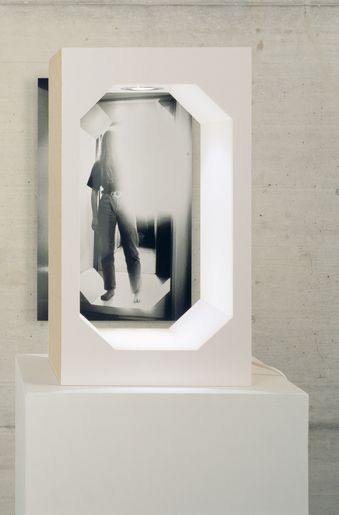Mein Schlafzimmer in Prag

Dorit Margreiter Choy
Mein Schlafzimmer in Prag, 1993
Model of the installation at Forum Stadtpark, Prague 4 parts Object, cardboard, integrated lighting, 50 x 28 x 19.6 cm black-and-white photograph, cibachrome, dry-mounted on aluminum 50 x 32 cm 2 pages text, 29.7 x 21 cm each, in German/English and Czech/English Invitation card
GF0000279.00.0-1997
Artwork text
May 1993, Prague, Krakovska 3. Behind the sign on the door, “Kechner,” is a fully furnished apartment known as “Forum Stadtpark Prague” rented by the Austrian Forum Stadtpark Graz as a residence, working, and exhibition space for invited artists. The entrance room is used as exhibition space; the bathroom, kitchen, and bedroom are available as living space for artists. The space between the entrance door and the following door forms a sort of mini-entrance hall through which one reaches the actual entrance room. This is followed by the bathroom and living room and from here one enters the adjacent bedroom. An additional partition wall with a door built for My Bedroom in Prague creates new boundaries within the spatial constellation and ensures that the entrance hall has the required appearance of a public or semi-public space. The space, explicitly set off as public space, also offers a sort of stage for projections resulting from the alluded display of an intimate private sphere. The hierar-chically differentiated suite of conventional living space—public, semi-public, private, intimate—is reversed here at a point which, in formal terms, bears some resemblance to the emancipatory thrust of the early 1970s (“Noth-ing is as public as the private”), but in reality it is a bizarre, but no less recognizable caricature of gender-specific ascription of place (both literally and abstractly). My Bedroom in Prague can be taken for a man’s bed-room only theoretically. Various public forms govern various spatial arrangements. The “real” visitor is confronted with an emblematic and minimal arrangement which is easily “narrated” to a per-son not present and which can be reproduced by the media. (Elisabeth Fiedler)

